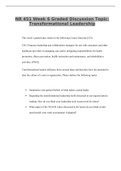©JOSHCLAY 2024/2025. YEAR PUBLISHED 2024.
MTTC History Exam (09) Part 1: World
History Questions and Answers 100%
Solved
Prehistory (definition and three periods) - ✔✔The period of human history
before writing was developed. The three periods are the Lower Paleolithic,
Upper Paleolithic, and Neolithic.
Lower Paleolithic - ✔✔About 1 million years ago. Humans used crude
tools. The "Old Stone Age". Early humans used tools
like needles, hatchets, awls, and cutting tools.
Upper Paleolithic - ✔✔Development of more specialized, better-made
tools. Humans began to wear clothes, practice art, and organize
themselves into groups with a definite social structure. Most lived in caves
during this period.
Neolithic - ✔✔Increased complexity of social structures (a sense of family,
religion, and government.) Domestication of animals, cultivation of crops.
,©JOSHCLAY 2024/2025. YEAR PUBLISHED 2024.
Humans built houses, started fires with friction tools. Knitting, spinning, and
weaving textiles.
Three Divisions of the Stone Age - ✔✔Paleolithic (with three sub-
categories), Mesolithic and Neolithic Eras.
Anthropology: Definition, description, and three major divisions. - ✔✔The
study of human culture.
Study groups of humans, how they relate to one another, and the
similarities and differences between different cultures by using cross-
cultural research and comparative research.
There are three major divisions within anthropology:
Biological and cultural anthropology
Archaeology
Linguistics
Archeology - ✔✔This discipline studies past human cultures by evaluating
what they leave behind. This can include
bones, buildings, art, tools, pottery, graves, and even trash.
,©JOSHCLAY 2024/2025. YEAR PUBLISHED 2024.
Archaeology teaches us that humans (or near-humans) have existed for
about 600,000 years. More primitive humans are believed to have
appeared about 1 million years ago. These humans developed into Cro-
Magnon man and then Homo sapiens.
Neolithic Age - ✔✔The "New Stone Age" from 8,000-6,000 BCE
(approximately). During this time textiles and pottery was developed, the
wheel was discovered, and people began to practice agriculture, make
polished tools, and had some domesticated animals.
Bronze Age - ✔✔3,000 BCE. Metals are discovered and the first
civilizations emerge as humans
become more technologically advanced.
Iron Age - ✔✔1,200-1,000 BCE. Metal tools replace stone tools as humans
develop knowledge of smelting.
Necessary elements of a Civilization - ✔✔Use of metal to make weapons
and tools
Written language
A defined territorial state
A calendar
, ©JOSHCLAY 2024/2025. YEAR PUBLISHED 2024.
The earliest civilizations developed in river valleys where reliable, fertile
land was easily found.
Earliest Civilizations - ✔✔4-3,000 BCE saw the development of the
civilizations in Mesopotamia (on Tigris and Euphrates Rivers) and in the
Nile River valley in Egypt. Both a part of the "Fertile Crescent".
Also, civilizations in:
Indus River
Hwang Ho in China
Fluvial civilizations - ✔✔Located near rivers and fresh water. Fresh water
was important because it could be used for:
Drinking water (for people and domesticated animals)
Cultivation of crops
Hunting along river (gathering place for wild animals)
rich soil deposits due to regular flooding.
Irrigation - ✔✔This technique helped direct water where it was most
needed--to sustain herds of domestic animals and to nourish crops (which
were increasing in size and quality.)





